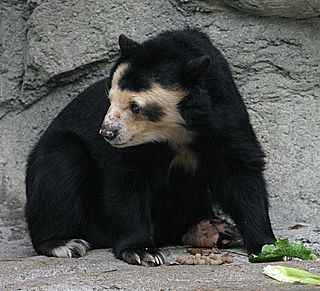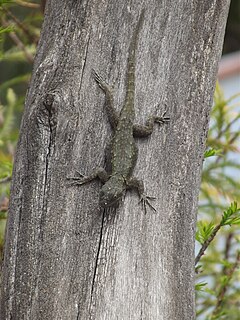
The spectacled bear, also known as the Andean bear or Andean short-faced bear and locally as jukumari (Aymara), ukumari (Quechua) or ukuku, is the last remaining short-faced bear. Its closest relatives are the extinct Florida spectacled bear, and the giant short-faced bears of the Middle to Late Pleistocene age. Spectacled bears are the only surviving species of bear native to South America, and the only surviving member of the subfamily Tremarctinae. The species is classified as Vulnerable by the IUCN because of habitat loss.

Urosaurus ornatus, commonly known as the ornate tree lizard, is a species of lizard native to the southwestern United States and northwestern Mexico. The species, which formerly was commonly called simply the "tree lizard", has been used to study physiological changes during the fight-or-flight response as related to stress and aggressive competition. Also, its life history and costs of reproduction have been documented in field populations in New Mexico and Arizona. Finally, it has been fairly well studied because it has interesting variation in throat color in males that can correlate with different reproductive strategies,

The ornate titi is a species of titi and is the smallest member of the family Pitheciidae, which also includes uakaris and saki monkeys. As it is a member of this family, it is classified as a type of New World monkey. It is endemic to eastern Colombia, and the only member of the Plecturocebus moloch group to occur north of the Rios Amazonas/Solimes/Napo axis, living at least 350 km away from the closest other member, the white-tailed titi, which lives in the south of Colombia. It was once classified as the same species as the white-tailed titi, but is now officially recognized as its own species. The ornate titi is also terrestrial.

The ornate wobbegong is a species of carpet shark that lives in Australia and possibly other countries in the Western Pacific Ocean. It is coloured golden brown, yellow-green and blueish-grey, and it grows to about 2.0–2.5 metres (6.6–8.2 ft). Described by Charles Walter De Vis in 1883, it is similar in appearance to other Australian wobbegongs and has previously been classified as the same species as the Gulf wobbegong. It is a nocturnal species, hunting at night, and it can bite humans when disturbed. The International Union for Conservation of Nature has listed it as a least-concern species.

The Gulf wobbegong or banded wobbegong is a species of carpet shark in the family Orectolobidae, found in southern Australia between Southport, Queensland and Norwegian Bay, Western Australia.

The harlequin bat is a species of bat in the family Vespertilionidae, the vesper bats. It is the only member of the monotypic genus Scotomanes.

The ornate flycatcher is a species of bird in the family Tyrannidae. It is the only member of the genus Myiotriccus. It is found in Colombia, Ecuador, and Peru.

The ornate cuscus or Molluccan cuscus is a species of marsupial in the family Phalangeridae. It is endemic to Indonesia, where it is found on the North Maluku islands of Halmahera, Bacan and Morotai, at elevations from sea level to 1000 m.

The ornate shrew, is a species of mammal in the family Soricidae (shrews). It is endemic to western North America, ranging from Northern California in the United States to Baja California in Mexico. Eight subspecies are known, including the extinct tule shrew, known only from four specimens collected in 1905, and the Suisun ornate shrew, a species of conservation concern in California. Through skull morphology research and genetic testing on Ornate shrew populations, it has been shown that there are three main genetic subdivisions: The Southern, Central and Northern. These three genetic subdivisions of Ornate shrew arose from populations of Ornate shrews getting geographically isolated from other populations.

The flower-faced bat is a species of bat in the family Hipposideridae. It is in the monotypic genus Anthops. It is found in the Autonomous Region of Bougainville of Papua New Guinea and in the Solomon Islands. This rare and little-known bat has been recorded from tropical moist forest and flying around village houses.

The ornate flying fox is a species of flying fox in the family Pteropodidae. It is endemic to New Caledonia. Its natural habitat is subtropical or tropical dry forests. It is threatened due to habitat destruction and hunting, the former exacerbated by high roost-site fidelity.

Orectolobus is a genus of carpet sharks in the family Orectolobidae. They are commonly known as wobbegongs, although this name also applies to the other members of the family. They are found in shallow temperate and tropical waters of the western Pacific Ocean and eastern Indian Ocean, chiefly around Australia and Indonesia, although one species occurs as far north as Japan.
Callinectes similis, sometimes called the lesser blue crab or dwarf crab, is a West Atlantic species of blue crab. It was described by Austin B. Williams in 1966.

Panulirus ornatus is a large edible spiny lobster with 11 larval stages that has been successfully bred in captivity.
Tragocephalini is a tribe of longhorn beetles of the Lamiinae subfamily. It was described by Thomson in 1857.
Spilotragus is a genus of longhorn beetles of the subfamily Lamiinae, containing the following species:
Spilotragus crucifer is a species of beetle in the family Cerambycidae. It was described by Per Olof Christopher Aurivillius in 1908. It is known from Somalia and Kenya.
Spilotragus clarkei is a species of beetle in the family Cerambycidae. It was described by Stephan von Breuning in 1976.
Spilotragus variabilis is a species of beetle in the family Cerambycidae. It was described by Jordan in 1897.
Spilotragus xanthus is a species of beetle in the family Cerambycidae. It was described by Jordan in 1903. It is known from Mozambique and the Democratic Republic of the Congo.













